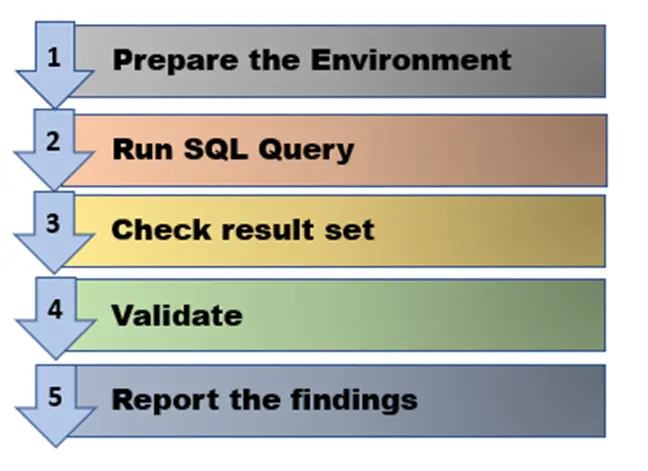
The database is an essential part of any system or application. It can be considered as the heart of any software application, so making sure that it is functioning correctly is essential. This is carried out in a controlled testing environment. The procedure is often referred to as data testing or back-end testing. It is an essential part of any system or application.
Why is Database Testing Important?
- Making sure that the values and data recorded in the database are accurate is the main goal of database (DB) testing.
- It speeds an overall cycle to create a room to test large data sets.
- It helps in processing complicated transactional behavior.
- Without a fully functioning database, an application cannot be put to proper use.
- Without proper DB testing, an application may have hidden faults. When using the software, this could mean that data is lost, not created, or incorrectly stored. This could have a major effect on the overall experience and effectiveness of the application.
What should be tested?
Database testing involves aspects of software which are not visible to the user, and this includes the flow of information through the app to the database.
The ACID properties validation is also included that accurately testing will be complete by covering these properties.

Database Testing Process
Testers might utilize a variety of tools for this process. However, the basic function remains the same. These necessary steps are included in the process:

For example, the tester and software developers will create all potential queries that can run through the application when setting up the environment. Running through these queries and examining the data integrity will then constitute the test. As a result, the information that is produced must be accurate, full, retrievable, and verifiable.
Types of Database Testing
Testing limited copies of databases and DB modifications can occasionally result in system failure, so testers should be careful to always have extra copies of the data available. While DB testing, it not only covers unit testing for databases. Instead of that it also includes many types of testing executed at a database.

Structural Testing
The purpose of structural DB testing is to validate those database elements that are hidden from end users. It involves all the repository’s elements that are used to store data and that end users cannot change. This testing is often carried out by database administrators who are proficient in SQL stored procedures and other topics. The chances of missing any error become very low.
Common components tested in Structural Testing
- Tables and Column Testing: Checks the datatypes, keys, indexes, naming conventions, length of data types and fields are maintained as per the requirement.
- Schema Testing: A tester can create straightforward queries in Microsoft SQL Server to examine and validate database schemas. The tester should make sure that all stored procedures using the affected table are compatible with any modifications they wish to make to the table’s structure.
- Stored Procedures and Views Testing: During this testing, a tester makes sure that manually running stored procedures and views produces the desired outcome. The tester ensures few points like, required triggers are executed, all operations are applied properly while fetching the data, exceptions and error handling are covered or not.
- Trigger Testing: Whether the trigger updates the data correctly, once they have been updated, Update/Insert/Delete trigger functionality about the application under test is validated.
Functional Testing
The aim of any functional testing is to ensure, everything documented in the specifications document is implemented as expected. A testing matrix that maps each requirement to one or more functional test cases and verification points comprehensive functional testing strategy.
Types of Functional Testing
- White Box Testing:
- Testing the internal structure of the Database.
- It involves the testing of database triggers and logical views, which are going to support database refactoring.
- Black Box Testing:
- Data mapping, verifying stored and retrieved data.
- Verifying the database integration during testing entails examining functionality. The test cases are straightforward and are used to validate both the function’s incoming and outgoing data.
Non-Functional Testing
Non-functional testing comprises load testing, stress testing, ensuring that minimum system criteria are met to satisfy business specifications, risk identification, and database performance optimization.
Types of Non-Functional Testing
- Security Testing: Database security includes protecting the database itself, to secure the database that accesses the data by allocating permissions to users in accordance with their roles.
- Stress Testing: Checks the software durability, stretches to its limits which evaluates the robustness. The most used stress testing tools are LoadRunner and WinRunner.
- Volume Testing: Database performance is analyzed by increasing the volume of data in the DB.
- Load Testing: This test determines how database behaves while being accessed by multiple users simultaneously.
- Smoke/ Sanity Testing: Compare the database with specifications to make sure it is functioning accordingly.
Database Testing Tools
- Few open-source Database testing tools are MySQL, Oracle, SQLServer and NoSQL Databases.
- Few commercial tools are, MS SQLServer, DTM Data Generator, Data Factory etc.
Conclusion
No matter what procedure and testing methods are used, the tester will have to have a strong grasp of both SQL (Structured Query Language) and DML (Data Manipulation Language). DB testing needs to cover the accuracy of business requirements as databases are not just for records storage and understand that keeping the privacy of user’s data is most important.






